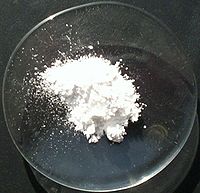
Photo from wikipedia
In situ remediation of groundwater by zerovalent iron (ZVI)-based technology faces the problems of rapid passivation, fast agglomeration, limited range of pollutants and secondary contamination. Here a new concept of… Click to show full abstract
In situ remediation of groundwater by zerovalent iron (ZVI)-based technology faces the problems of rapid passivation, fast agglomeration, limited range of pollutants and secondary contamination. Here a new concept of Magnesium-Aluminum (Mg-Al) alloys and in situ layered double hydroxides on is proposed for the degradation and removal of a wide variety of inorganic and organic pollutants from groundwater. The Mg-Al alloy provides the electrons for the chemical reduction and/or the degradation of pollutants while released Mg 2+, Al 3+ and OH - ions react to generate in situ LDH precipitates, incorporating other divalent and trivalent metals and oxyanions pollutants and further adsorbing the micropollutants. The Mg-Al alloy outperforms ZVI for treating acidic, synthetic groundwater samples contaminated by complex chemical mixtures of heavy metals (Cd 2+, Cr 6+, Cu 2+, Ni 2+ and Zn 2+), nitrate, AsO 3 3-, methyl blue, trichloroacetic acid and glyphosate. Specifically, the Mg-Al alloy achieves removal efficiency ≥99.7% for these multiple pollutants at concentrations ranging between 10 and 50 mg L -1 without producing any secondary contaminants. In contrast, ZVI removal efficiency did not exceed 90% and secondary contamination up to 220 mg L -1 Fe was observed. Overall, this study provides a new alternative approach to develop efficient, cost-effective and green remediation for water and groundwater.
Journal Title: Environmental research
Year Published: 2021
Link to full text (if available)
Share on Social Media: Sign Up to like & get
recommendations!